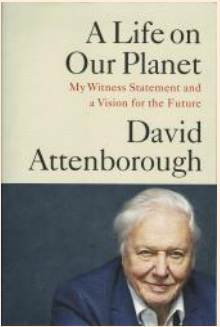BOOK REVIEW: A Life on Our Planet – My Witness Statement by David Attenborough – By Wimal Kannangara
Source : Brisbane Sri Lankan Newsletter – Dæhæna – September 2022
To anyone interested in nature and conservation, David Attenborough needs no introduction. Sir David Attenborough is Britain’s, if not the world’s, best known natural history documentary maker. Having joined BBC as a trainee producer in 1952, he rose to become the Controller of BBC2 during which time he introduced colour television to Britain and then to be the Director of Programmes for BBC Television. Then in 1973, he abandoned administration to be documentary making and writing. The rest is history.
 His witness statement covers the period 1937 when he was 11 years old to 2020 when he was 94 when this book was written. During this period, the world population grew from 2.3 billion to 7.8 billion and the remaining wilderness declined from 66 per cent to 35 per cent.
His witness statement covers the period 1937 when he was 11 years old to 2020 when he was 94 when this book was written. During this period, the world population grew from 2.3 billion to 7.8 billion and the remaining wilderness declined from 66 per cent to 35 per cent.
The book explains the development of life on earth, slow and steady for the most part, interrupted by five mass extinctions. Each time the nature collapsed leaving only a few survivors to start the process again. The last time it happened was 66 million years ago changing the course of natural history, wiping out three-quarters of all species including the 175-million-year reign of the dinosaurs. For 66 million years since then, nature has been at work reconstructing the living world, creating and refining a diversity of species. One of those species is humanity.
Since the retrieval of the glaciers, past 10,000 years or so known as Holocene has been one of the most stable periods of the planet. This stability led to the rhythm of the seasons and humans made use of these to start farming. Farming transformed the relationship between humans and nature.
Identifying the use of fossil fuels as the greatest challenge the author identifies vested interests as the most formidable challenge with six of the ten major companies in the world being oil and gas companies. The quest for perpetual growth and measurement of development using crude measures such as GDP leading to the rapid decline in the balance with nature Right now, per UN’s earth overshoot day, humans consume 1.7 times the amount of resources that the planet can produce. If this trend continues the planet will come to an irreversible tipping point.
In the section “Vision for the Future”, the book discusses the measures for a sustainable economy as three “P”s – profit, people and planet. The hope is that a “sustainability revolution” will bring products and services that reduce the impact on the planet just the way, industrial revolution and digital revolution brought prosperity.
The book concludes that Anthropocene (the geological period in which the human activity has been the dominant influence on climate and the environment) which some say started in 1950s, could be a uniquely brief period, one that ends the human civilisation unless the human species come together to save the planet and indeed themselves.
Wimal Kannangara







